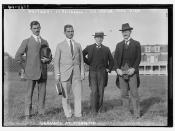These excerpt are taken from the source I have chosen to evaluate, a 1929 play called "Journey's End". It was composed by a British author R.C. Sherriff who joined the war at age eighteen. He served as a captain in the East Surrey regiment from 1914 until the end of the war.
This makes the play a first hand account, so it would be useful to historians studying the soldier's experience of trench warfare. Again, because Sheriff was actually there, the source is far more reliable than one by a writer who hadn't fought in WW1.
The play takes place in a British trench, and is set in St. Quentin, which was an area key to the German defence of the Somme line. The excerpt I have chosen has characters discussing raids about to be made on the Germans the day before a planned attack by the Allies.
"Lots of raids have taken place along the line today.
With the attack tomorrow morning, headquarters naturally want all the information they can get as early as possible."
Trench raiding was a mixture of inter-battalion competitive aggression and a search for prisoners and intelligence. Raiding parties consisted of 10-200 men, and army commanders from both sides would often launch raids. The commanders viewed the raids as useful because they restored an offensive spirit and promoted attrition, especially since there would be more casualties in the enemy's camp than the raiding troops.
Both the Allies and the Triple Alliance would send their raiders across No Man's land to observe, eavesdrop or penetrate the enemy line, gathering information which their side could use to their advantage when planning a strike. The raiders could also ascertain movements of the enemy, which might indicate a forthcoming attack. Another role of the raiders was to capture prisoners.


